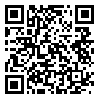BibTeX | RIS | EndNote | Medlars | ProCite | Reference Manager | RefWorks
Send citation to:
URL: http://jdisabilstud.org/article-1-2887-en.html
2- Assistant Professor, Department of Psychology, Shahrood Branch, Islamic Azad University, Shahrood, Iran
3- Department of Cognitive Sciences, Faculty of Psychology and Educational Sciences, Semnan University, Semnan, Iran
Background & Objectives: In Iran, studies and statistical indicators indicate an elderly rapid growth; accordingly, as expected in 2031, an aging explosion will occur in our country. Furthermore, 25% to 30% of the population will be over the age of 50 years by then. Thus, it is essential to pay attention to the health of the aging population. Moreover, a critical approach to reducing the complications associated with aging is to increase activity among the aging population. Active aging should be considered a multidimensional and multilevel concept that can simultaneously be applied to individual levels and for policymaking. Additionally, an important aspect of health in the elderly is the psychological dimension. Besides, this aspect requires special attention and prevention of disorders, such as depression and anxiety in them. Therefore, this study aimed to provide a structural model of communication and well–being skills of the elderly with the mediating role of self–compassion.
Methods: The research method was descriptive–analytical using structural equation modeling. The statistical population of this study included all the elderly living in nursing homes located in the cities of Gilan Province, Iran in 2019–2020. Fifteen people are needed to select the sample size in modeling research for each obvious variable. There are also 12 obvious variables based on the variables in the research conceptual model. Therefore, 180 people were needed in this study. However, because all the questionnaires might not be completed by the participants, 250 questionnaires were distributed, of which 210 questionnaires were fully completed and analyzed. Data were collected using Oxford Happiness Questionnaire (Hills & Argyle, 2002), Self–Compassion Scale (Neff, 2003) and Interpersonal Communication Skills Questionnaire (Queendom, 2004). The inclusion criteria were as follows: being elderly, having a minimum level of diploma education, lacking a specific physical illness or psychological disorder, not under special psychological treatment or medication. The exclusion criterion was a lack of cooperation in completing the questionnaires. In this research, descriptive statistics indicators (prevalence, percentage, mean and standard deviation) were used. The Pearson correlation coefficient and structural equation modeling were also used. The data were analyzed in SPSS version 24 and AMOS version 24 using the structural equation modeling method. The significance level of all statistical tests was considered 0.05.
Results: Examining the coefficients of the direct path between different paths showed significant direct relationships between communication skills and self–compassion (p<0.001, Beta=1.1), between communication skills and happiness (p<0.001, Beta=0.62) and between self–compassion and happiness (p<0.001, Beta=0.37). Also, the indirect effect of communication skill on happiness with the mediating role of self–compassion was equal to 4.8 (p=0.013). The goodness of fit indices of the fitted conceptual model were obtained as (CMIN/df=3.05, GFI=0.96, NFI=0.97, RMSEA=0.086).
Conclusion: According to the findings, strengthening communication skills in the elderly by increasing their compassion will increase their happiness.
| Rights and permissions | |
 |
This work is licensed under a Creative Commons Attribution-NonCommercial 4.0 International License. |



